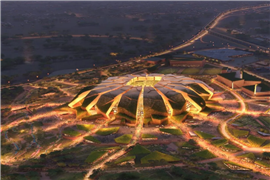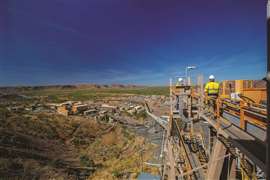Read this article in 中文 Français Deutsch Italiano Português Español
Saudi construction activity high but can it be sustained?
29 November 2024
The US-Saudi Business Council (USSBC) – a bilaterally mandated international trade and development non-profit meant to increase and facilitate investment between the US and Saudi Arabia – announced its second quarter analysis of construction contracts for work in the Kingdom of Saudi Arabia (KSA). While construction activity is high, questions about how sustainable it is are starting to emerge.
 Tower cranes at work in Riyadh, Saudi Arabia, circa 2023. (Image: Adobe Stock)
Tower cranes at work in Riyadh, Saudi Arabia, circa 2023. (Image: Adobe Stock)
“The pace of contract awards has been unabated and growing at a record pace,” said Albara’a Alwazir, USSBC’s director of economic research during an analysis of the second quarter data shared with Construction Briefing. “Oil-and-gas, real estate, and water sectors are keeping the momentum from the first quarter into the second quarter.”
The data on construction contracts in KSA showed a modest dip from an 11-year high in Q1 2024, with the value dropping from US$32 billion to $18 billion in Q2. Like Q1, oil-and-gas contracts led the way at more than 40% of work, and real estate represented a quarter of contracts. Water contracts dropped 9% quarter-to-quarter, while power-utility work jumped up about 5% (see chart below).
Despite the drop between quarters, construction contract value is estimated at just less than US$50 billion by the mid-point of this year. Only halfway through 2024, that figure is only a few billion dollars short of 2022’s total and about $22 billion away from 2023’s total.
“[And] 2023 was an extremely successful year in terms of contract awards,” said Alwazir. “I’ve tracked this data going back to 2007, and what we’re seeing right now through 2024 – at least the first half – is the highest on record in Saudi Arabia.”
Where are firms getting contracts in Saudi Arabia?
 (Table courtesy US-Saudi Business Council)
(Table courtesy US-Saudi Business Council)
The majority of work (59% or $10 billion) was awarded in the Eastern Province, driven by Saudi Aramco’s Fadhili Gas Plant expansion project.
The Riyadh region (which includes the capital city) represented 15% of US-Saudi contracts in the quarter.
“Of the 35 contracts awarded in Riyadh, the real estate sector had the largest share of awarded contracts with 25 projects worth $1.5 billion or 56% of the total. A single contract worth $600 million was awarded in the education sector pertaining to the construction of King Salman University in Diriyah Gate,” stated the USSBC Q2 report.
Tabuk Province (where the $1.5 trillion megaproject Neom is located) made up 13% of US work in the Kingdom of Saudi Arabia (KSA).
The report continued, “There were eight contracts awarded in Tabuk, which was dominated by Neom across numerous sectors. Neom awarded four contracts worth $1.5 billion, while Red Sea Global awarded three contracts worth $664 million.”
Is the Saudi construction pace sustainable?
While oil and gas projects accounted for the bulk of projects awarded in Q2, non-oil contracts driven by the Kingdom’s Vision 2030 initiative to diversify its economy and draw in tourists from around the world to ambitious projects like those in the Neom special economic zone were also a significant part of the mix.
Saudi Arabia’s Public Investment Fund (PIF) – valued at just less than $1 trillion – has been pouring billions of dollars into projects like the 170km linear city The Line and mountain tourism destination Trojena. It is also building new stadiums and sporting facilities like the King Salman stadium in Riyadh, ahead of Saudi Arabia hosting the 2034 World Cup.
That has led some to question whether even a wealthy, oil-rich nation like Saudi Arabia can afford to fund so many huge projects that are still years away from making any sort of return, and have suggested that it may need to scale back its plans.
Earlier this year, for example, a Bloomberg report suggested that The Line, would be scaled back and build in stages at a slower pace. The first of those stages would be just 2.4km long and house 300,000 people rather than the nine million intended for the full build.
Andrew Leber, a researcher at Tulane University in Louisiana, US, focuses on the political economy of the Middle East, told CNBC he believes that the current pace of spending won’t last.
“The number of ‘we pay up front and hope for economic returns later’ giga-projects that are currently underway is not sustainable,” he said. “I do think that, eventually, a number of projects will be quietly shelved in order to bring its fiscal outlays back into greater sustainability.”
“With that being said,” he added, “the Saudi monarchy has shown itself to be somewhat flexible whenever economic realities assert themselves.”
Saudi officials ‘confident’ on maintaining spending
As for KSA’s perspective, Saudi finance minister Mohammed Al-Jadaan told the news outlet he’s confident that Saudi Arabia’s spending levels are sustainable.
In October, Saudi Arabia cut its growth forecasts and raised its budget deficit estimates for the fiscal years 2024 to 2026 as it expects a period of higher spending and lower projected oil revenues.
 An artistic render of The Line, a Neom project in Saudi Arabia. (Image: Neom)
An artistic render of The Line, a Neom project in Saudi Arabia. (Image: Neom)
Real gross domestic product is now expected to grow 0.8% this year, a dramatic drop from a previous estimate of 4.4%, according to the ministry of finance.
The Kingdom’s economy also swung from a budget surplus of $27.7 billion in 2022 to a deficit of $21.6 billion in 2023 as it ramped up public spending and decreased oil production due to its OPEC+ supply cut agreement.
Its government forecasts a deficit of $21.1 billion for 2024, projecting revenue at $312.5 billion and expenditures at $333.5 billion. Saudi authorities expect that the budget will remain in deficit for the next several years as it pursues its Vision 2030 plans, but they add that they are fully prepared for this.
“Our non-oil revenues have grown significantly, now it covers about 37% of expenditure. That’s a significant diversification, and that gives you a lot of comfort that you can manoeuvre and be stable despite the fluctuation in oil price,” Al-Jadaan told CNBC in October.
Outlook for construction contract awards
Offering his outlook on contract awards in Saudi Arabia, Alwazir said that substantial investments in infrastructure provided a robust foundation for job creation in the construction and industrial sectors in the short term, as well as high demand for construction materials like cement.
 Alabara’a Alwazir
Alabara’a Alwazir
Over the medium term, he pointed to an opportunity to strengthen public-private partnerships, particularly on large-scale infrastructure projects like Neom, where private investors and international firms, including in the US, are becoming key players.
Alwazir said, “With continued regulatory improvements and incentives for Foreign Direct Investment (FDI), the Kingdom can attract a diverse array of global firms, fostering innovation and knowledge transfer to the local market.
“The real estate sector, which has secured numerous contracts in residential and commercial spaces, is likely to see sustained interest from both domestic and international investors, with opportunities for expanding affordable housing, retail, and mixed-use developments that will meet the needs of a growing, urbanizing population. Furthermore, the government’s investments in advanced water infrastructure, including desalination and sewage treatment, will support both urban growth and industrial expansion in water-scarce regions.”
He went as far as to say that Saudi Arabia could become a model for effective collaboration between government and private entities in the delivery of large-scale infrastructure projects with the help of a stronger legislative framework that supports greater private sector participation and foreign investment.
“Saudi Arabia’s investment surge in infrastructure and diversification efforts is not just a response to present economic needs but a calculated step toward a sustainable, globally integrated future. By fostering private sector growth, attracting international investment, and developing a resilient infrastructure backbone, Saudi Arabia is positioning itself as a diversified economic powerhouse,” Alwazir concluded.
STAY CONNECTED


Receive the information you need when you need it through our world-leading magazines, newsletters and daily briefings.
CONNECT WITH THE TEAM












